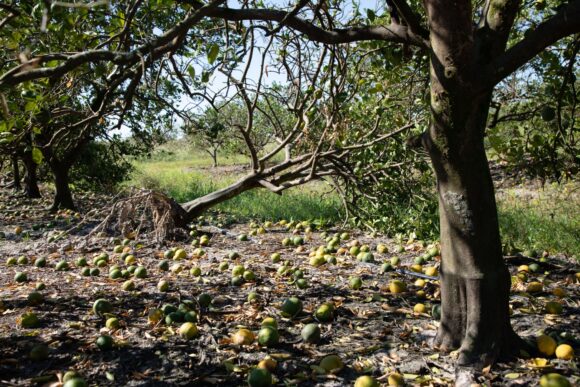Florida’s produce industry took an almost $2 billion hit from Hurricane Ian and is now bracing for more as Tropical Storm Nicole follows a track toward the state’s eastern shores.
The Sunshine State is the top US supplier of fruits and vegetables in fall and winter months and the country’s second-biggest producer overall after California, which is battling an unprecedented water crisis that’s left hundreds of thousands of farmland acres unplanted this year. Florida’s produce industry represents 140,000 jobs and $19.8 billion in sales, according to the International Fresh Produce Association.
“Many of our growers were significantly impacted by Hurricane Ian and are seeing upwards of $1.8 billion in damages across the industry and as much as 50% of the citrus crop affected, so we are watching Tropical Storm Nicole closely, hoping for the best, but always preparing to deal with the conditions as they come,” said Cathy Burns, chief executive officer of IFPA.
The storm is so wide that it will affect the entire peninsula, according to Drew Lerner at World Weather Inc. The storm may cause some damage to sugarcane, of which Florida is a top producer, and citrus, though at its current strength, damage could be minimal. But with the size of the crop this year, every piece of fruit counts.
Florida is the country’s biggest producer of oranges used to make juice. Production this year is already set to plunge to the lowest in almost eight decades even without factoring the impact of Hurricane Ian in September. The state has seen its citrus acreage devastated by a crop disease called citrus greening which elevated costs, while urban sprawl and decades-long damage from hurricanes also discouraged investments in the sector.
Dean Mixon, already lost 50% of this year’s potential crop and is still trying to secure fruit from other counties that weren’t hit as hard by Ian to satisfy his packing commitments. He’s closely monitoring the situation, he said.
The storm could also hurt quality for some of the cotton still waiting for harvest in parts of Georgia and the Carolinas.
Was this article valuable?
Here are more articles you may enjoy.


 Ticketmaster May Have Broken Law With ‘Platinum’ Oasis Seats
Ticketmaster May Have Broken Law With ‘Platinum’ Oasis Seats  Auto Insurer Fined for Data Breach That Impacted 45K New Yorkers
Auto Insurer Fined for Data Breach That Impacted 45K New Yorkers  Trump’s Tariffs Threaten to Endanger the Cheap American Car
Trump’s Tariffs Threaten to Endanger the Cheap American Car  What Claims Pros Must Know About Small Businesses’ Insurance Blind Spots
What Claims Pros Must Know About Small Businesses’ Insurance Blind Spots 